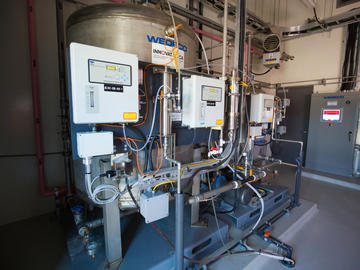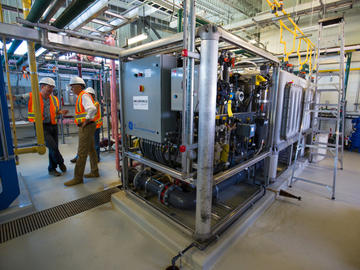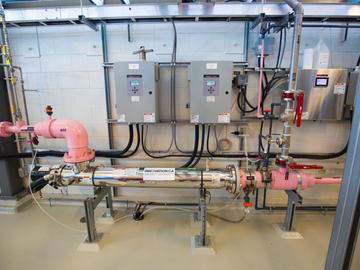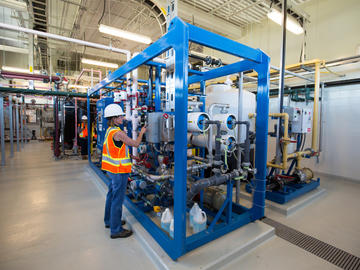Wastewater research facility
ACWA's advanced tertiary treatment modules draw from a full-scale wastewater treatment plant and provide a testing platform for advanced treatment
ACWA’s four advanced tertiary treatment modules draw 510,000 L/day from secondary clarifiers of the full-scale wastewater treatment plant and provide a testing platform for advanced treatment. Modules include membrane (ultra- and nano-filtration) and advanced oxidation (O3 or H2O2) with and without UV. The modules can be configured in series or parallel and can be individually evaluated and can deliver treated effluent to research streams to measure receiving environment effects.
Specifications
ACWA's research plant receives 510,000 L/day of secondary effluent from the Pine Creek WWTC secondary clarifiers. This effluent flows through an Ultra Filtration Membrane system and the flow is then directed to the following advanced treatment modules, operating either in series, or in parallel at 170,000 L/day:
- Advanced Oxidation (H2O2 and UV)
- Ozonation (O3)
- Reverse Osmosis
The facility combines established treatment technologies with space to house the technologies of the future. Flexible piping routed through the plant allows the investigation of different process configurations.
An integrated Supervisory Control and Data Acquisition (SCADA) system allows researchers to monitor and control all the processes in the research plant. The ACWA research plant allows researchers to test and manipulate the efficacy of several process trains in the removal of microconstituents. Final effluent can be directed to the research streams to examine the impact of various treatment methods on aquatic life under control conditions.
Additional liquid processes will be accommodated within the ACWA facility to allow the in-depth study of the complete spectrum of technologies, from the current membrane technologies to processes not even imagined today.
Effluent from the ACWA research facility can be:
- Returned to the headworks of the City of Calgary Pine Creek WWTC, or
- Diverted to one or more of the ACWA research streams to investigate environmental impacts and processes
The facility combines established treatment technologies with space to house the technologies of the future. Configurable piping routed through the plant allows the investigation of different process combinations.
An integrated Supervisory Control and Data Acquisition (SCADA) system allows researchers to monitor and control all the processes in the research plant. The ACWA research plant allows researchers to test and manipulate the efficacy of several process trains in the removal of microconstituents and emerging contaminants of concern. Final effluent can be directed to the research streams to examine the impact of various treatment methods on aquatic life under controlled conditions.
Additional technologies and processes can be accommodated within the ACWA facility to allow the in-depth study of the complete spectrum of technologies, from the current membrane technologies to processes not even imagined today.
Effluent from the ACWA research facility can be:
- Returned to the headworks of the City of Calgary Pine Creek WWTC, or
- Diverted to one or more of the ACWA research streams to investigate environmental impacts and processes.





